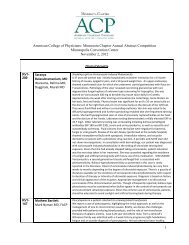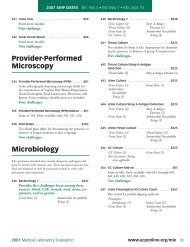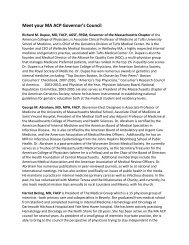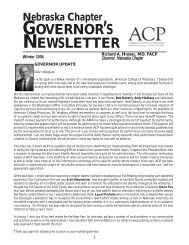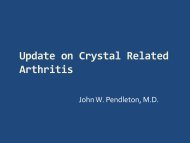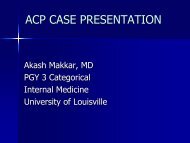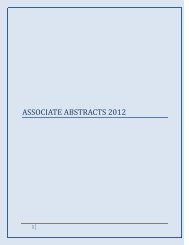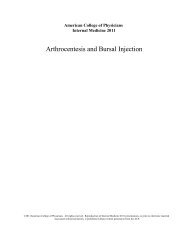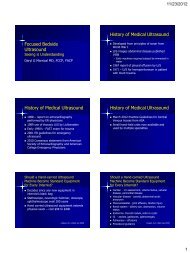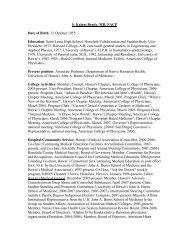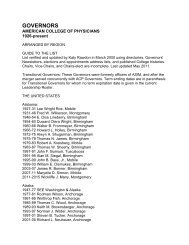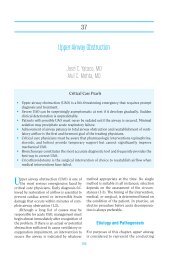The Role of Pharmacists in Clinical Care: Where Do We Go from ...
The Role of Pharmacists in Clinical Care: Where Do We Go from ...
The Role of Pharmacists in Clinical Care: Where Do We Go from ...
You also want an ePaper? Increase the reach of your titles
YUMPU automatically turns print PDFs into web optimized ePapers that Google loves.
TABLE 1<br />
ACP Positions on Pharmacist Scope <strong>of</strong> Practice and Potential for Research<br />
ACP–ASIM POSITION*<br />
RATIONALE*<br />
FURTHER RESEARCH TO EXAMINE<br />
Supports research <strong>in</strong>to<br />
the effects <strong>of</strong> pharmacy<br />
automation and the move<br />
to the PharmD degree<br />
Supports physician-directed<br />
collaborative practice agreements<br />
between the pharmacist<br />
and the physician, limited<br />
to pharmacist <strong>in</strong>volvement<br />
<strong>in</strong> patient education<br />
and hospital rounds<br />
Opposed <strong>in</strong>dependent<br />
pharmacist prescription<br />
privileges and <strong>in</strong>itiation <strong>of</strong><br />
drug therapy<br />
Supports the use <strong>of</strong> the<br />
pharmacist as immunization<br />
<strong>in</strong>formation source. . .immunizer,<br />
as appropriate<br />
Reiterates its support <strong>of</strong><br />
its 1990 therapeutic<br />
substitution position<br />
Store-based pharmacists currently spend<br />
over 60% <strong>of</strong> their time process<strong>in</strong>g and<br />
dispens<strong>in</strong>g orders; automation and<br />
pharmacy technicians will free up this<br />
time<br />
PharmD degree has expanded cl<strong>in</strong>ical<br />
tra<strong>in</strong><strong>in</strong>g<br />
Pharmacist <strong>in</strong>terventions <strong>in</strong> the hospital<br />
sett<strong>in</strong>g have been successful <strong>in</strong> improv<strong>in</strong>g<br />
cl<strong>in</strong>ical outcomes, reduc<strong>in</strong>g cost,<br />
and reduc<strong>in</strong>g adverse events<br />
Question if pharmacist tra<strong>in</strong><strong>in</strong>g is sufficient<br />
for <strong>in</strong>dependent <strong>in</strong>itiation <strong>of</strong> medications<br />
No evidence to support this activity<br />
30 states already allow pharmacists to<br />
give immunizations<br />
Pharmacies are a readily accessible site<br />
and can <strong>in</strong>crease immunization rates<br />
Supports previous position<br />
In accordance with American College <strong>of</strong><br />
Cl<strong>in</strong>ical Pharmacy<br />
Expand<strong>in</strong>g roles <strong>of</strong> community<br />
pharmacist<br />
Level <strong>of</strong> autonomy for community<br />
pharmacists<br />
Impact <strong>of</strong> PharmD tra<strong>in</strong><strong>in</strong>g<br />
Organizational structures to enhance<br />
physician–pharmacist communication<br />
Technologies (e.g., Internet, automated<br />
phone systems, home monitor<strong>in</strong>g<br />
equipment) that can improve this<br />
communication<br />
Pharmacist role <strong>in</strong> community-based,<br />
disease state management <strong>in</strong> the<br />
outpatient sett<strong>in</strong>g<br />
Practical programs and protocols that are<br />
acceptable to patients, pharmacists, and<br />
physicians<br />
Pharmacist prescrib<strong>in</strong>g under close<br />
guidel<strong>in</strong>es and supervision<br />
Effect <strong>of</strong> these programs on improv<strong>in</strong>g<br />
patient outcomes and cost-effectiveness<br />
Effect <strong>of</strong> these actions on improv<strong>in</strong>g<br />
patient outcomes and cost-effectiveness<br />
*Adapted <strong>from</strong> P<strong>in</strong>cus and colleagues. 6 ACP–ASIM = American College <strong>of</strong> Physicians–American Society <strong>of</strong> Internal Medic<strong>in</strong>e.<br />
Medic<strong>in</strong>e (ACP–ASIM) 6 recognizes the <strong>in</strong>creas<strong>in</strong>g scope<br />
<strong>of</strong> pharmacists and outl<strong>in</strong>es “how the medical pr<strong>of</strong>ession<br />
can work with pharmacists to enhance patient safety<br />
and quality <strong>of</strong> care.” Table 1 describes these positions,<br />
their rationale, and areas for future research.<br />
Empirical evidence about the benefits <strong>of</strong> pharmaceutical<br />
care has been generally positive, but the strength<br />
<strong>of</strong> the evidence is problematic. Several randomized trials<br />
have shown that cl<strong>in</strong>ical pharmacists can play a key<br />
role <strong>in</strong> disease management models for anticoagulation<br />
treatment, hypertension, hyperlipidemia, asthma, and<br />
other chronic conditions. 8–11 However, several recent literature<br />
reviews suggest that the enthusiastic reports are<br />
<strong>of</strong>ten plagued by serious design flaws, lack <strong>of</strong> controls,<br />
absence <strong>of</strong> appropriate controls, <strong>in</strong>correct analyses (e.g.,<br />
report<strong>in</strong>g with<strong>in</strong>-group rather than between-group<br />
comparisons), small sample sizes, short follow-up periods,<br />
and lack <strong>of</strong> patient outcome data. 12–15 <strong>The</strong>se reviews<br />
suggest that there is evidence support<strong>in</strong>g the effectiveness<br />
<strong>of</strong> pharmaceutical care delivered dur<strong>in</strong>g hospital<br />
admissions, less evidence <strong>in</strong> outpatient sett<strong>in</strong>gs, and no<br />
well-designed studies support<strong>in</strong>g the effectiveness <strong>of</strong><br />
pharmaceutical care <strong>in</strong> retail pharmacies. One recent<br />
review 13 identified 21 studies conducted <strong>in</strong> community<br />
pharmacy sett<strong>in</strong>gs that measured the impact <strong>of</strong> pharmaceutical<br />
services on patient outcomes. <strong>The</strong> authors<br />
found that many <strong>of</strong> these studies had significant<br />
methodologic problems, and none evaluated the impact<br />
<strong>of</strong> pharmaceutical care on economic, cl<strong>in</strong>ical, and<br />
humanistic outcomes. <strong>The</strong> authors recommend that<br />
pharmaceutical services <strong>in</strong> community and ambulatory<br />
care sett<strong>in</strong>gs should be evaluated us<strong>in</strong>g multisite randomized<br />
trials that attend to the forego<strong>in</strong>g issues. 13<br />
In this issue <strong>of</strong> ecp, Fischer and colleagues 16 take<br />
a step toward evaluat<strong>in</strong>g the impact <strong>of</strong> community pharmacists<br />
on patient outcomes. In this nonrandomized but<br />
92<br />
•<br />
Effective Cl<strong>in</strong>ical Practice ■ March/April 2002 Volume 5 Number 2



